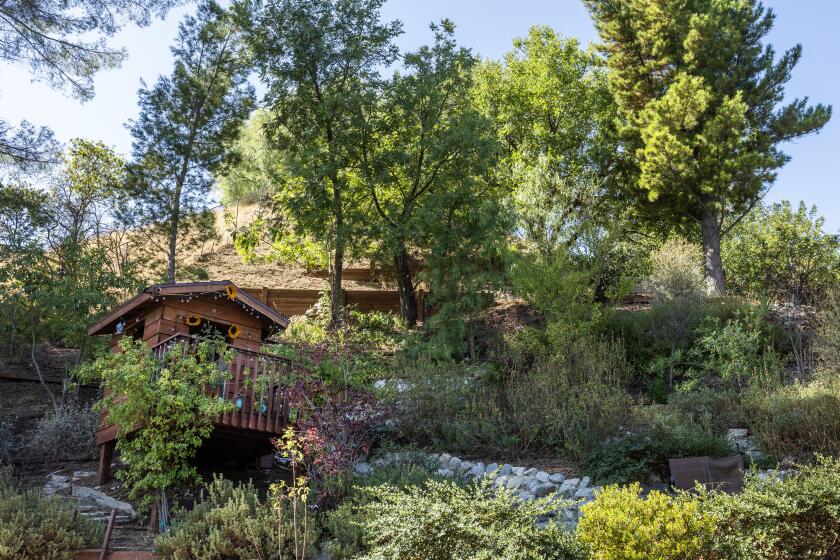A Mountain’s Magic : Nature: Bob and Pat Chapman help urban children discover the wonder of the great outdoors at their ranch above Claremont.
The mountain man grabbed the mallet with a calloused hand and swung it hard at the huge iron cylinder hanging near the grassy meadow.
The deep, rumbling tone from the 500-pound chime traveled across a nearby pond and echoed off the side of 6,924-foot-high Sugarloaf Peak. In a distant grove of cedar trees, the sound caused a woodpecker to abruptly stop its attack on a tree trunk.
“Here’s a high note,” said 76-year-old Bob Chapman, striking a smaller chime. “We try to have the children understand different sounds.”
For 10 years, Chapman and his wife, Pat, have brought schoolchildren to their mountain above Claremont to show them how to listen to what nature has to say.
Bob Chapman knows. Even though he has been deaf since age 4, when a scarlet fever outbreak hit a nearby canyon where his family lived in a log cabin.
Chapman “hears” the chime by touching it and imagining the sound resonating off the granite face of the nearby mountain.
He hears the roar of a cascading waterfall by feeling the stinging spray from a cold mountain stream tumbling down the mountainside a few hundred feet from his hand-built home.
He hears the faint buzz of the bees pollinating the mountain wildflowers by watching them flit against the delicate lilac and poppy blossoms.
In the majestic silence of his mountain, Chapman is intent on sharing a lifetime of love of the outdoors with children from the Pomona Valley down below.
He has built a barn-like classroom warmed by potbellied stoves where Pat Chapman and others teach children about erosion and wildlife habitats and the importance of the sun to plant growth.
He has built five miles of trails across the couple’s 40-acre ranch for youngsters to hike on as they learn to identify poison oak leaves, strange rock formations and animal tracks.
There is a camouflaged hut for bird-watching, a bee house where honey bees and their queen can be observed up close, a hen house where children can collect eggs, and a stable housing burros like those ridden 100 years ago by settlers coming to San Antonio Canyon, south of Mt. Baldy.
The buildings have a rustic, mountain look: Most are built with lumber from Chapman’s own sawmill. Fittings and such things as the scrap-metal chimes are forged in Chapman’s own blacksmith shop.
“I learned blacksmithing from my father. We had to make all our own tools back in those days,” explained Chapman, whose parents taught him to read lips and speak.
His parents came to the mountain as newlyweds on horseback in 1901. They spent their honeymoon camped in a tent beneath the same oak grove where visiting schoolchildren now play on rope-and-tire swings.
Chapman’s parents operated a weekend and summer resort in Icehouse Canyon before purchasing the ranchland near Mt. Baldy Village in 1929. Not much would grow in the sandy, granite soil, however. The Chapman men earned their living by helping build houses and resort buildings in the mountains.
Life was idyllic for a boy growing up in the canyon.
Bighorn sheep, mountain lions, bears and deer abounded. Trout would all but leap from the streams and grab a fishing hook. Skiing was as close as the back door. Chapman spent one glorious summer trooping through the mountains, mapping all of the natural springs in the area for the U.S. Geological Survey.
But life could be harsh, too. Thirteen major floods have roared through the canyon during his lifetime, Chapman said. Blizzards have isolated the area for days at a time. Devastating brush and forest fires have swept through. So have avalanches.
A 1944 avalanche killed two of Chapman’s best friends. He honored them by writing a poem and casting it on a bronze plaque on his forge. Later that year, he mounted it on a rock near where they died.
“Jewels you sprinkle over your beloved mountains,” Chapman wrote. “Go high in peace amidst them--Forever your mountaineer, Bob.”
Pat Chapman met her husband 30 years ago when she came to the mountain to teach at the local school. The Chapman Ranch was one of the places she tried to rent a room.
“He was so smart. He could do just about anything. He could make just about anything with his hands,” she said of the man she married the next year.
The pair settled in a one-room cabin that Chapman and his father had built in 1931. Soon they were raising two sons of their own.
Pat Chapman continued teaching at the Mt. Baldy School. She began inviting her students to the ranch on field trips. Chapman was surprised at how delighted city children were to visit the ranch.
Word of the ranch trips spread and the Chapmans were soon getting calls from other schools wanting to visit. In the early 1980s, Pat Chapman quit her school job to devote herself full time to her ranch tours.
A nonprofit board of directors was formed in 1989 as both the curriculum and the number of ranch visitors continued to grow. About $70,000 a year--raised through grants, donations and fees paid by schools--pays for teaching materials and for small stipends for the 10 people who lead hikes and classes. The outings attracted about 5,000 children last year.
“Pat and Bob are committed to getting urban kids into the mountains,” said Elene Kallimanis, science teacher at Pomona’s Kellogg Polytechnic Elementary School, which sent 62 kindergartners to the ranch last week. “We can see these mountains looming over where we live. When these children come up here when they’re older, they’ll know how important it is to preserve it.”
Kindergarten teacher Kathy Gibson helped put makeshift grocery bag “knapsacks” on her pupils before accompanying them on a short hike. The trail led them past a waterfall, across a mountain stream and through deep, shady woods where footsteps were cushioned by a thick carpet of fallen oak leaves.
“These kids are from an area that’s mostly houses. They’re certainly seeing things they don’t see in their neighborhood,” Gibson said.
Mark Sepulveda, 6, agreed: “I saw a black bird with a little bit of white on it and I saw a squirrel going down a tree. I don’t have them at home.”
Before leaving, the children raced tiny cork boats in a small creek, studied insect life in algae pulled from a ranch pond and got a close-up view of orioles, woodpeckers and blue jays in the ranch’s bird sanctuary.
Pat Chapman used toy bees on sticks and toy blossoms to demonstrate flower parts and the role that pollination plays in ecology as the children zigzagged their way across the meadow, buzzing loudly.
Bob Chapman watched as the children’s bus pulled away for the trip down the mountain. Walking back to the ranch house, he paused and glanced toward still-snowy Sugarloaf Peak.
“I was up at Lupine Meadow last week with seventh- and eighth-graders. We stopped and had lunch there. The meadow was covered with wildflowers,” he said.
“It was heaven.”
Outdoor Classroom Bob and Pat Chapman teach school children to listen to nature in the mountains above the Pomona Valley.
More to Read
Sign up for Essential California
The most important California stories and recommendations in your inbox every morning.
You may occasionally receive promotional content from the Los Angeles Times.











